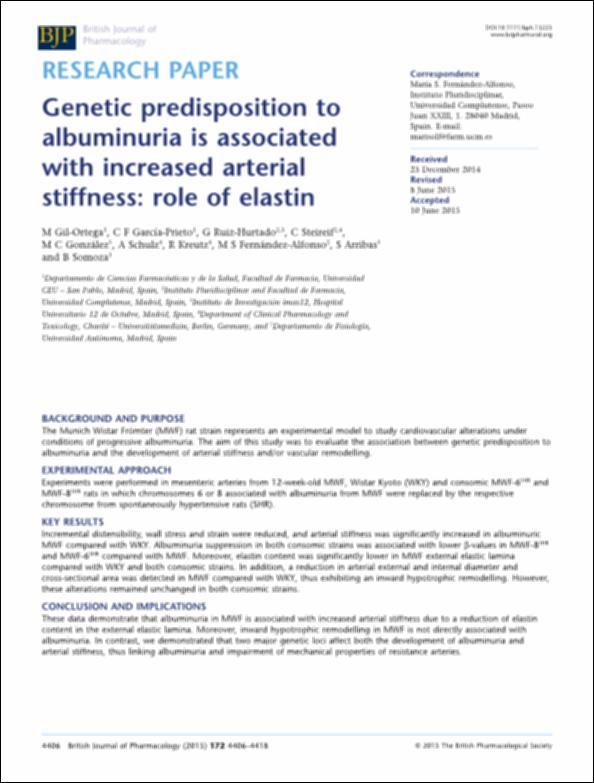Por favor, use este identificador para citar o enlazar este ítem:
http://hdl.handle.net/10637/14618Genetic predisposition to albuminuria is associated with increased arterial stiffness role of elastin
| Título : | Genetic predisposition to albuminuria is associated with increased arterial stiffness role of elastin |
| Autor : | Gil Ortega, Marta García Prieto, Concepción F. Ruiz Hurtado, G. Steireif, C. González, María del Carmen Kreutz, Reinhold Fernández Alfonso, María Soledad Arribas Rodríguez, Silvia Magdalena Somoza Hernández, Beatriz |
| Materias: | Cardiovascular alterations; Genetic predisposition |
| Editorial : | British Pharmacological Society |
| Citación : | Gil-Ortega M, García-Prieto CF, Ruiz-Hurtado G, Steireif C, González MC, Schulz A, Kreutz R, Fernández-Alfonso MS, Arribas S, Somoza B. Genetic predisposition to albuminuria is associated with increased arterial stiffness: role of elastin. Br J Pharmacol. 2015 Sep;172(17):4406-18. doi: 10.1111/bph.13223 . Epub 2015 Jul 21 |
| Resumen : | The Munich Wistar Frömter (MWF) rat strain represents an experimental model to study cardiovascular alterations under conditions of progressive albuminuria. The aim of this study was to evaluate the association between genetic predisposition to albuminuria and the development of arterial stiffness and/or vascular remodelling. Experiments were performed in mesenteric arteries from 12-week-old MWF, Wistar Kyoto (WKY) and consomic MWF-6SHR and MWF-8SHR rats in which chromosomes 6 or 8 associated with albuminuria from MWF were replaced by the respective chromosome from spontaneously hypertensive rats (SHR). Incremental distensibility, wall stress and strain were reduced, and arterial stiffness was significantly increased in albuminuric MWF compared with WKY. Albuminuria suppression in both consomic strains was associated with lower β-values in MWF-8SHR and MWF-6SHR compared with MWF. Moreover, elastin content was significantly lower in MWF external elastic lamina compared with WKY and both consomic strains. In addition, a reduction in arterial external and internal diameter and cross-sectional area was detected in MWF compared with WKY, thus exhibiting an inward hypotrophic remodelling. However, these alterations remained unchanged in both consomic strains. These data demonstrate that albuminuria in MWF is associated with increased arterial stiffness due to a reduction of elastin content in the external elastic lamina. Moreover, inward hypotrophic remodelling in MWF is not directly associated with albuminuria. In contrast, we demonstrated that two major genetic loci affect both the development of albuminuria and arterial stiffness, thus linking albuminuria and impairment of mechanical properties of resistance arteries. |
| URI : | http://hdl.handle.net/10637/14618 |
| Derechos: | http://creativecommons.org/licenses/by-nc-nd/4.0/deed.es OpenAccess |
| ISSN : | 1476-5381 |
| Fecha de publicación : | 21-jun-2015 |
| Centro : | Universidad San Pablo-CEU |
| Aparece en las colecciones: | Facultad de Farmacia |
Los ítems de DSpace están protegidos por copyright, con todos los derechos reservados, a menos que se indique lo contrario.


